NASA's Saturn probe "Cassini" has entered the atmosphere of Saturn and put an end to his 20-year mission

At around 19:30 on September 15, 2017 in Japan time, Saturn probe that NASA and ESA (European Space Agency) etc operatedCassini"Entered Saturn's atmosphere, burned out due to high fever and high pressure due to the speed of speed, and finished his life. In operation for about 20 years, Cassini offered us many scientific findings of Saturn and the beautiful Saturn's appearance to mankind.
NASA's Cassini Spacecraft Ends Its Historic Exploration of Saturn | NASA
https://www.nasa.gov/press-release/nasa-s-cassini-spacecraft-ends-its-historic-exploration-of-saturn
Saturn probe Cassini called official name "Cassini-Huygens" (Cassini · Huygens), was launched from the Cape Canaveral Space Station in Florida, USA on 15th October 1997, and it is the end of a trip of about 5 years and 8 months Was put into orbit around Saturn. For nearly 13 years, Cassini has newly discovered the satellites that had not been known before, and the satellite "Enceladus"Water is present and active surface activity is occurringI discovered that. In addition, we delivered a photographic image clearly capturing Saturn from the vicinity to the Earth, and landed the planetary probe "Huygens probe" that was equipped on Saturn's satellite, Titan, and the atmospheric composition, wind speed, temperature, It has brought many scientific discoveries, such as directly observing atmospheric pressure etc from the satellite.
And on the morning of September 15, 2017 Eastern time of the United States, Cassini entered the atmosphere of Saturn as planned because "not to introduce microorganisms possibly adhering to the aircraft to the satellite" as a plan, high fever and high pressure It burned out completely. I was monitoring the last momentNASA Jet Propulsion LaboratoryThe state of the control room of YouTube is also released on YouTube. The following movies are their digest version.
Final Moments in Cassini Mission Control - YouTube
A control team that monitors the data sent from Cassini and watches breathlessly as Cassini's last moment approaches. It will take 83 minutes at this moment before radio waves emitted from Cassini reach the earth. In other words, we are watching the state of Cassini 83 minutes ago.

The frequency graph of the radio waves captured by the antenna has only one sharp protrusion, which shows radio waves from Cassini. After the air controller heard the voice saying "Data observation is now switched to high rate mode (high speed mode) and it is entering the atmosphere ..."

At last the signal was interrupted and the graph became a flat shape.

A situation is reported from a woman in the section labeled Radio Science "the signal has been lost".

I do not know with this digest version, but at that moment the control room was wrapped in silence.

After interaction "Flight Director to Project Manager" "Continue", Flight Director Julie Weber sent a sentence "Declaration of Signal at 11: 56: 46". This "11:56:46" indicates the world standard time, which is 6:56:46 AM at Eastern Standard Time (daylight saving time) with the control room.

In response to this, Dr. Earl Mays of Project Manager, who led the project, said, "From the Project Manager of FSO co-ord (Co-flight System Operation). While some of the remaining signals have arrived yet, The signal from the probe was declared to have been lost, and in the next 45 minutes the spacecraft will be lost as well. "

"I hope all of us will be proud of this wonderful achievement, congratulations everyone.That was a wonderful mission, a wonderful spacecraft, and everyone was a wonderful team, here we declare the end of the mission. I will finish the communication. " In the control room wrapped in applause, it was seen that each other hugged and fighting a good fight.

Cassini, who has been orbiting Saturn for 13 years, began his last mission on April 26, 2017, to do fly-bys that will pass through the space between Saturn's ring and the planet body 22 times. By literally touching the atmosphere of Saturn, we performed the most accurate last data collection. The state of the plan is also touched in the following article.
The spacecraft "Cassini" that accomplished many discoveries about Saturn went to the end, and finally it passed through the ring of Saturn and evaporated in Saturn's atmosphere in September 2017 - GIGAZINE

I will look back over the schedule of that "final" again. The curtain of "Grand Finale" opens April 26, 2017.

In the final mission, Cassini carried out valuable investigations that he could not have done so far. It passes between Saturn's ring and Saturn and collects data near Saturn.
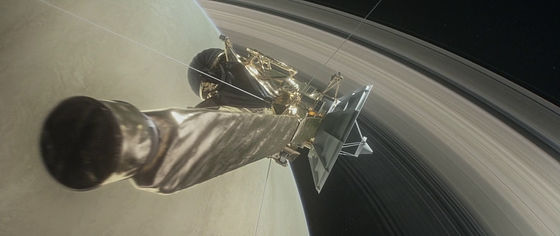
That data should be valuable which no one could ever get. It is expected to gain valuable insight to know the origins of Saturn's ring.
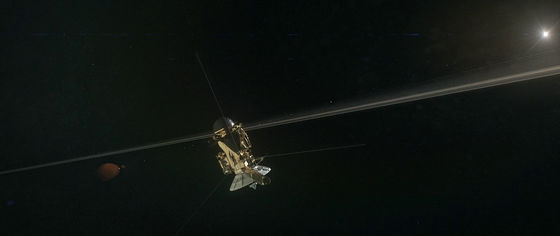
Saturn is a gas planet with a diameter of about 9 times that of the Earth. It may be like this ring from such Saturn. Cassini is the most artificial thing that approached Saturn so far.
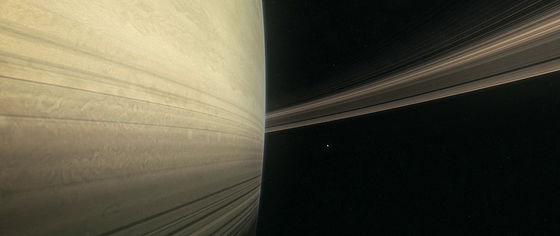
And on the lap of the 22nd lap, Cassini will close that lifetime. A strong force will be applied to the aircraft entering Saturn's atmosphere and flying at high speed.
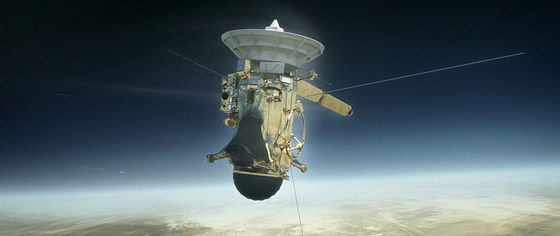
Even in such a situation, Cassini is programmed to always point the antenna to the Earth and will continue to send valuable Saturn's atmospheric data obtained until the last moment to Earth.

When the altitude goes down, the friction with the atmosphere gradually becomes strong ...
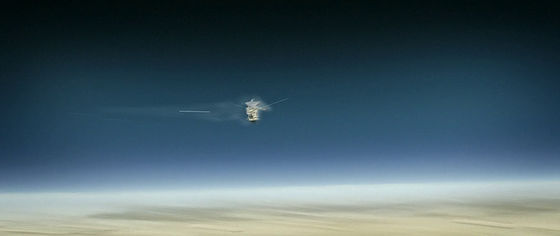
Cassini's body can not bear heat and collapse begins.
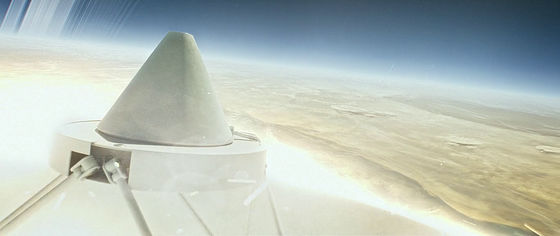
And on September 15, 2017, Cassini is finally scattered in pieces, it will evaporate and become part of Saturn's atmosphere and will finish his life.

This is one of the pictures that Cassini sent last. The satellite "Enceladus" sinks behind Saturn's body that shines white.

Cassini took a picture of the spot where he himself enters the atmosphere beforehand. It was confirmed to rush toward the center of the following photos.

The following movie shows the last two times of the 22 Saturn fly-bys that Cassini went last. It was Cassini who had been orbiting precisely between Saturn and Saturn's ring while changing trajectory little by little, but at the last fly-by, it approaches the satellite "Titan" at the most distant point from Saturn. At this time Titan's attraction causes the Cassini's trajectory to change slightly and finally it will rush into Saturn's atmosphere by taking a trajectory that can not escape Saturn's attraction. The situation is accurate and precise as goose bumps stand, but what kind of calculations do you plan on this orbit can be impossible to imagine.
Animation of Cassini's Last Two Orbits of Saturn - YouTube
Infragraph related to Cassini's final "Grand finale". With 22 fly-bys, Saturn's cloud of atmospheric clouds is about 1628 km further. The space between Saturn's main body and the ring of Saturn is only 2400 km, during which Cassini passes at a tremendous speed of about 123,000 km / h. Five of them will gather the atmosphere of Saturn, four times go inside the ring "D ring" closest to Saturn. Then, after entering the atmosphere in the last flyby, communication with Cassini will cease in one minute.

A lot of pictures taken by Cassini are published at the gallery site of NASA, and it is also possible to download 395 5921 raw data which has not been corrected. Although it is designed to be able to download all at once, as of September 16th of the article posting, the comment "It can not be downloaded in bulk until traffic settles down" was displayed.
Cassini: The Grand Finale: Images
https://saturn.jpl.nasa.gov/galleries/images/

The timeline from Saturn flyby that Cassini last went to Grand Finale has also been released. According to this, Cassini photographed the picture at the end on September 14, then rotated to turn the antenna toward the earth at around 3 am on September 15, shifting to a position to perform real time transfer of data . The throughput at that time seems to be 27 kbps (3.4 kB / s).
Cassini: The Grand Finale: End of Mission Timeline
https://saturn.jpl.nasa.gov/mission/grand-finale/cassini-end-of-mission-timeline/

The appearance of live relaying of the state of the control room at the Grand Finale with a 360 degree camera has also been released. Cassini's last moment will be visited after about 57 minutes and 30 seconds of the movie.
NASA Mission Control Live: Cassini's Finale at Saturn (360 video) - YouTube
◆ bonus
Speaking of the last aircraft that has entered the celestial body, it is famous for the comet explorer "Rosetta" operated by ESA (European Space Agency). Along with the comet landing aircraft "Philae" which is a companion, there seems to have been a lot of people who empathize without feeling unexpectedly in the dramatic development of finishing a difficult mission on the same comet and welcoming the end on the same comet .
Comet probe Rosetta succeeded in the last mission "Comet Fall", finishing the 12-year mission with Aibo Pharaoh - GIGAZINE

Related Posts:







